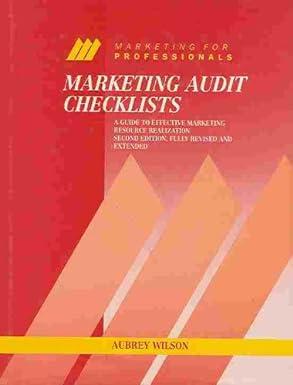Question
Hello. I noticed in Chegg's textbook solutions section for Financial and Managerial Accounting for MBA's 4th edition, chapter 8 question 58 is missing an answer.
Hello.
I noticed in Chegg's textbook solutions section for Financial and Managerial Accounting for MBA's 4th edition, chapter 8 question 58 is missing an answer. Will you please solve question 58 in chapter 8 please.
Q8-58 Interpreting Disclosure on Share-Based Compensation
Intel reported the following information in its 2012 10-k related to its restricted stock plan.
Information with respect to outstanding restricted stock unit (RSU) activity is as follows:
| In millions, Except per RSU amounts | Number of RSUs | Weighted Average Grant-Date Fair Value |
| December 26 2009 | 14-Apr | $17.03 |
| Granted | 32.4 | 22.56 |
| Vested | -34.6 | 17.7 |
| Forfeited | -3.4 | 17.98 |
|
| ---------------- | ---------------- |
| December 25, 2010 | 99.8 | 18.56 |
| Granted | 43.3 | 19.86 |
| Assumed in acquisition | 5.8 | 20.8 |
| Vested | -37.5 | 18.6 |
| Forfeited | -4.4 | 19.07 |
|
| ---------------- | ---------------- |
| December 31, 2011 | 107 | 19.18 |
| Granted | 49.9 | 25.32 |
| Vested | -43.2 | 18.88 |
| Forfeited | -4.4 | 20.93 |
|
| ---------------- | ---------------- |
| December 29,2012 | 109.3 | 22.03 |
|
| ---------------- | ---------------- |
| Expected to vest as of December 29, 2012 | 103.5 | 20.21 |
The aggregate fair value of awards that vested in 2012 was $1.2 billion ($753 million in 2011 and $808 million in 2010), which represents the market value of Intel common stock on the date that the restricted stock units vested. The grant-date fair value of awards that vested in 2012 was $816 million ($697 million in 2011 and $612 million in 2010). The number of restricted stock units vested includes shares that we withheld on behalf of employees to satisfy the minimum statutory tax withholding requirements. Restricted stock units that are expected to vest are net of estimated future forfeitures. As of December 29, 2012, there was $1.5 billion in unrecognized compensation costs related to restricted stock unites granted under our equity incentive plans.
Required
a. How do restricted stock and stock options differ? In what respects are they the same?
b. Why do companies impose vesting periods on restricted stock grants?
c. Use the financial statement effects template to record the restricted stock granted to senior executives during 2012. The common stock has a par value of $0.001 per share.
d. Use the financial statement effects template to record the 2012 compensation expense related to Intels restricted stock awards. (Hint: The expense is equal to the grant-date fair value of the RSUs that vested during the year.)
Thanks.
Step by Step Solution
There are 3 Steps involved in it
Step: 1

Get Instant Access to Expert-Tailored Solutions
See step-by-step solutions with expert insights and AI powered tools for academic success
Step: 2

Step: 3

Ace Your Homework with AI
Get the answers you need in no time with our AI-driven, step-by-step assistance
Get Started


